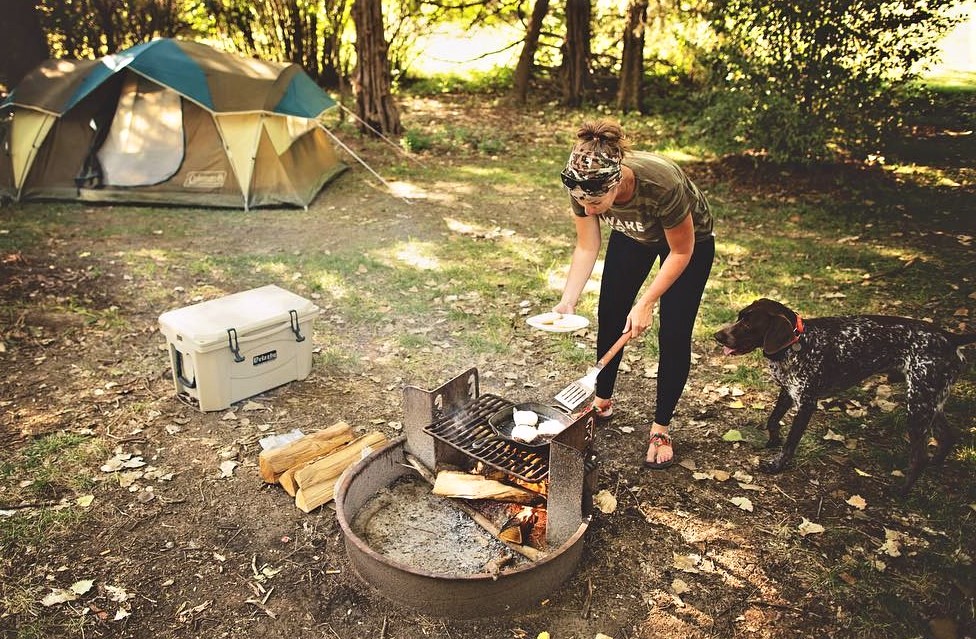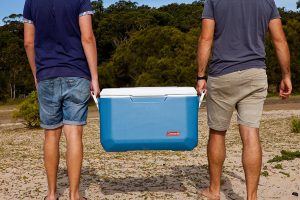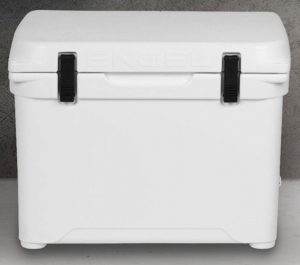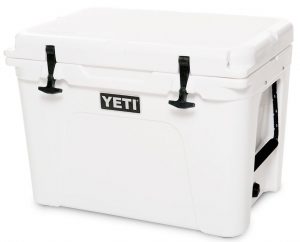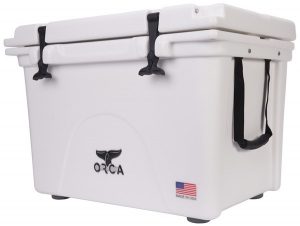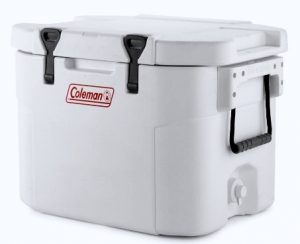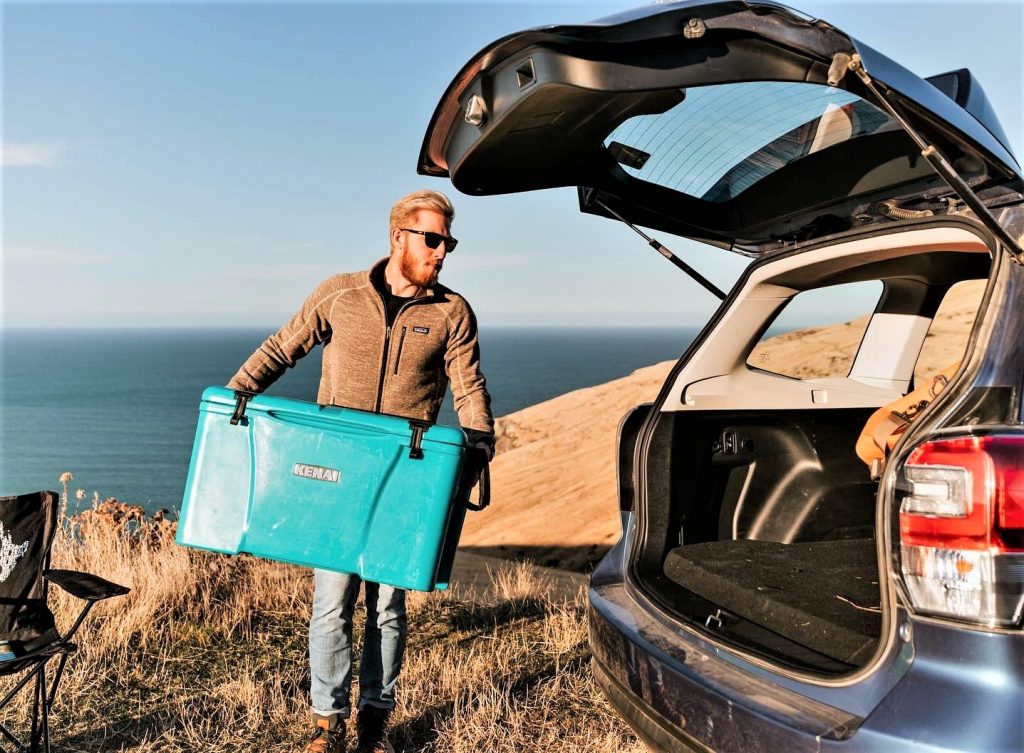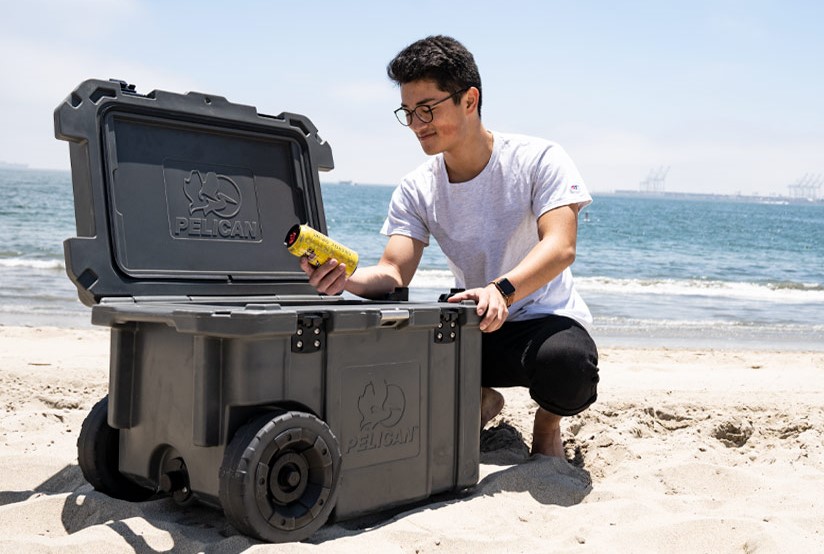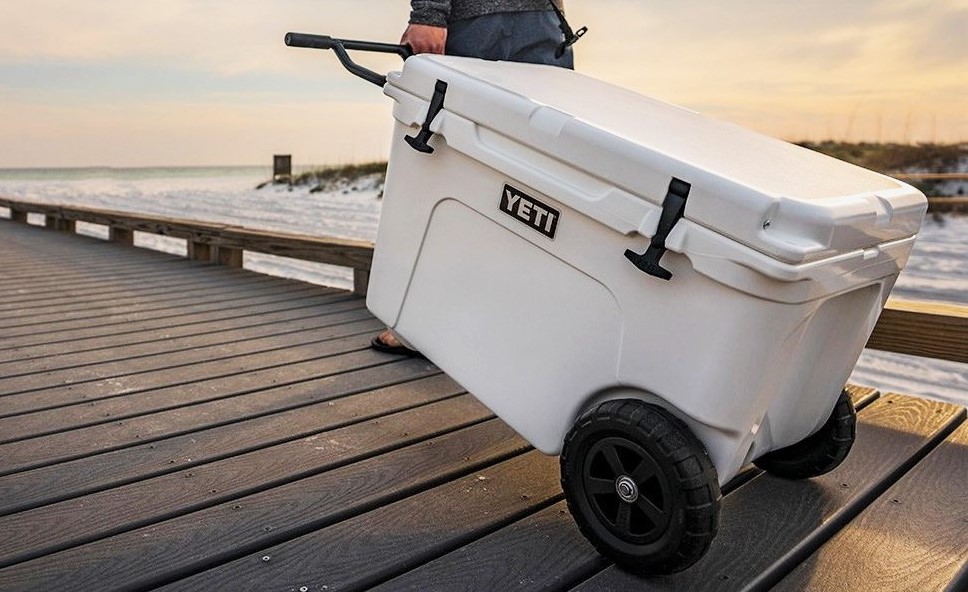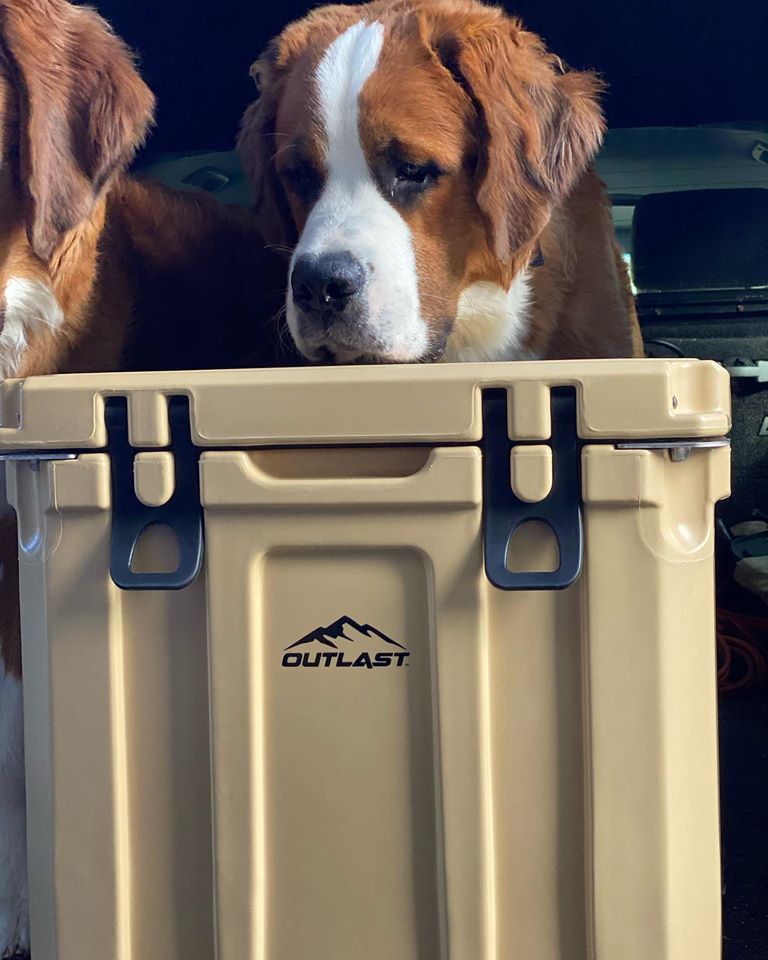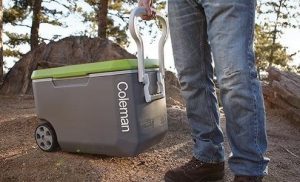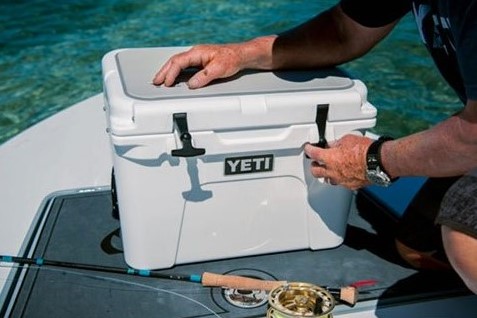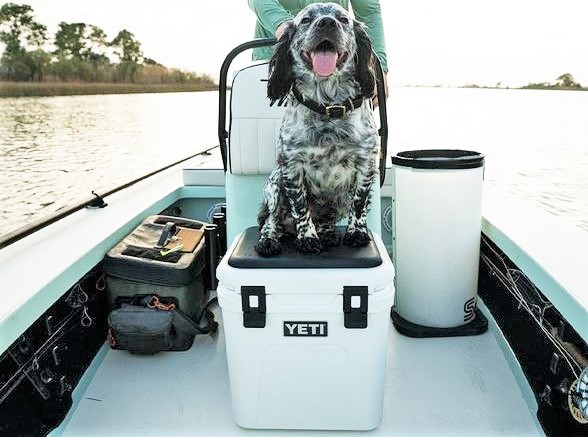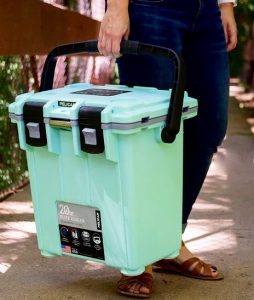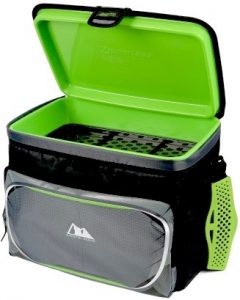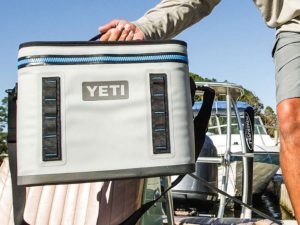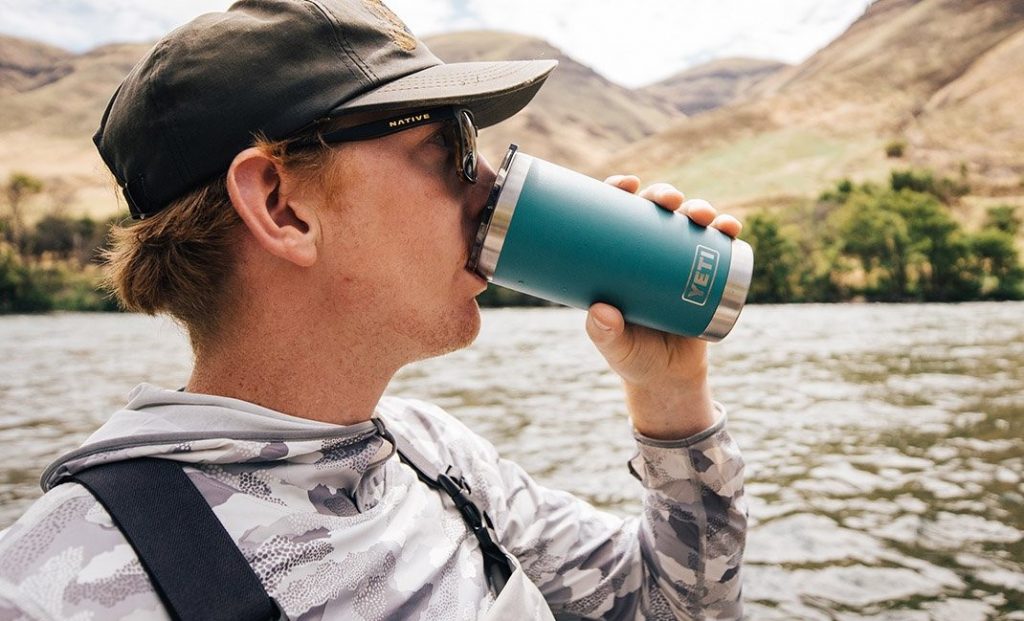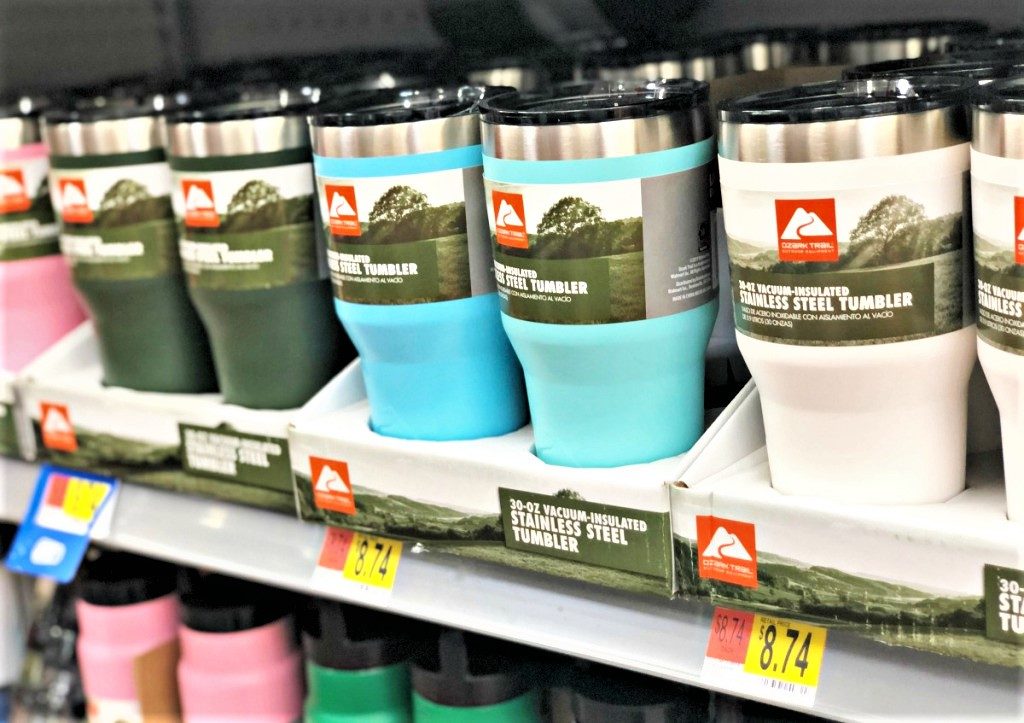The Living Clean Guide to Less-Toxic Camping Gear – Coolers & Refrigerators
May 1, 2018
By Lisa Petrison, Ph.D.
(Draft Version)
STORAGE COOLERS
The challenge of keeping food cold seems to have undergone a revolution since I was tent camping full-time almost ten years ago.
Heavy-duty coolers sold by Yeti and its competitors now chill food and drinks for up to a week in hot weather (and even longer in moderate weather) without an ice change, but prices also are very high.
After having purchased and used some of these coolers myself, I think that they may have the potential of being helpful to many people pursuing camping for extended periods of time, for mold avoidance reasons or for other reasons.
I think that their use will allow many people to more easily get out into remote areas for extended periods of time without having to resort to eating whatever random toxic food might be locally available; without needing to spend the money and effort to bring along a generator or solar system in order to run a refrigerator; and without being forced to constantly focus attention on the chore of buying and replacing cooler ice.
However, these coolers also have their downsides, meaning that they are not always going to be appropriate even for those who can afford them.
For one thing, because they contain large amounts of insulation, they can take up a large amount of available space in the vehicle.
In addition, most of these coolers can be moved only with the combined efforts of two healthy people when they are full.
In many cases, even the medium-sized coolers when empty may be too much for some people to be able to move when alone.
Figuring out logistics of how to handle and periodically drain the cooler therefore is really important.
In many cases, I tend to think that the heavier high-end coolers are going to be useful for people only if the coolers can be kept in one place all the time rather than needing to be moved around.
For instance, for those who are traveling with a cargo van or a cargo trailer, the cooler could be placed right next to the back door, allowing it to be periodically drained through its drain hole or with a siphon hose.
Those who are not set up for the cooler to be drained in this way may find that they are much better off with a different kind of cooler, such as an ordinary lighter plastic cooler with wheels (which is what I used to have) or a smaller heavy-duty cooler (such as less than 40 quarts) that they can lift even when it is full.
In short, choosing the right cooler is not just a matter of picking the most expensive or most attractive product and then being done with it.
Rather, it likely will require some thought with regard to what the goals for the cooler are going to be and how the problems associated with it are going to be solved.
CHEAP COOLERS
For those who do not need, cannot afford or are not set up to be able to use these higher-end storage coolers, a number of other very good cooler choices exist.
Quite a few other larger coolers also are available at much lower prices than any of these models, of course.
I have not seen any others that I would expect to compare on either ice retention or quality construction, though probably there are some out there.
Note that from what I have seen of non-rotomolded coolers, larger coolers of 30 quarts or more virtually all have drain plugs, while smaller coolers never do.
The version that I owned back in the day had wheels on it, and I found those to be very helpful when taking the cooler out of my SUV to change the ice or for general campground use.
One problem that I have with many of these less expensive coolers is that at least at first, the plastic produces a lot of offgassing. This tends to be especially problematic when the coolers are open.
I did not have any problem at all with the Coleman Steel Belted Cooler with regard to this though.
Although I have not yet seen the Stanley 30-quart cooler, the similar smaller Stanley coolers have only mild offgassing issues by my standards.
The Rubbermaid coolers that I have encountered also haven’t seemed too bad with regard to offgassing, and therefore conceivably could be worth a look and a sniff.
Additional Information:
Coolers On Sale – Camping Coolers
Outdoor Gear Lab – Best Coolers
Outdoor Gear Lab – How To Choose a Cooler
The Cooler Zone – Best Camping Coolers
Outside Pursuits – Camping Coolers
My Trail Company – Camping Coolers
What’s Inside? – $400 vs. $50 Cooler
HEAVY-DUTY COOLERS
Today’s high-end coolers are larger and heavier than other coolers of the same size, due to the presence of large amounts of insulation as well as thicker plastic materials.
In most cases these coolers are rotomolded, though very high-quality coolers may be made using other manufacturing techniques as well.
These coolers are intended to be once-in-a-lifetime purchases and usually contain at least two inches of insulation on all sides and in the lid.
Although it is unlikely that those purchasing these coolers will end up discarding them, I suggest not stressing out too much about choosing the exact right cooler to meet all needs into the future.
The resale market for these coolers is very good, meaning that if a decision is made down the line that a different cooler would be more appropriate, selling the existing unit and using the money to buy something else should be a fairly simple process.
Additional Information:
Field & Stream – Large Coolers
CoolersOnSale.com – Large Coolers
Backpackerverse – Car Camping Coolers
CoolersOnSale.com – Small Coolers
Clever Leverage – Cheap Rotomolded Coolers
Outdoorsman Time – Adventure Coolers
Best Cooler Reviews – Rotomolded Coolers
Four Wheeler – High-End Cooler Shootout
Field and Stream – Coleman Esky
Expedition Portal – Esky Cooler
Fitness Travel Gear – Esky Cooler
Survival Cooking – Walmart Ozark Trail vs. Yeti
COOLER SIZE
As a general rule, coolers are broken up into the categories of 20 Quart (which seems possibly appropriate for storage of food but not drinks for two people for maybe a day), 30-45 Quarts (possibly appropriate for two people for a couple of days), 50-65 Quarts (possibly appropriate for two people for several days), 70-90 Quarts (possibly appropriate for two people for up to 5-6 days) and 95+ quarts (possibly appropriate for two people for up to a week or more).


A 165-Quart Grizzly Cooler providing a little less than 6 cubic feet of storage space for ice and food.
Of course, the amount of storage space needed can vary significantly depending on what kind of refrigerated food is being consumed (e.g. produce, dairy products and beverages will take up more room); whether food that does not need to be kept chilled (such as grains, beans or canned goods) is a significant part of the diet; how many people are being fed; and how big everyone’s appetites are.
Only after comparing the available space in a cooler to that of a refrigerator did it become clear to me how limited the space in a cooler actually is.
Standard home refrigerators in the U.S. typically are 15-30 cubic feet. The RV refrigerator that I used to have in my Casita (which seemed an appropriate size to meet most of my basic needs while on the road) was 4 cubic feet.
While a 60 quart cooler is technically 2 cubic feet, generally it is recommended that coolers be stocked with only 50% food so that the rest of the cooler can hold ice.
In some cases – especially in hot weather or on long trips – an even higher ice-to-food ratio is often suggested.
That being the case, it seems that even a large heavy-duty cooler will provide only a fraction of the storage space as does a modest-sized RV refrigerator.
The main reason for this is that coolers with a great deal of insulation have a relatively small percentage of storage space compared to the total size of the cooler.
That is especially the case with smaller heavy-duty coolers, which usually have the same amount of insulation on each side (such as 2″) as do larger coolers from the same manufacturer.
A higher percentage of storage space can be provided either by purchasing a less insulated cooler or by using less ice, but then ice retention will not be as great.
While a heavily insulated smaller cooler will have limited storage space and still take up a lot of room in the car, overly large coolers present significant problems as well.
For instance, they may take up a very high percentage of all available floor space, be difficult or impossible for one person to move even when empty, and require the purchase of large amounts of ice to keep them filled.
Thinking hard about exactly what needs to be stored and how cold it needs to be thus is important.
For instance, in my case, I realized that a high percentage of the food that I eat consists of fresh produce that does not need to be kept all that cold.
I therefore have been considering buying an inexpensive lightweight cooler to use for the produce, rather than keeping it in my storage cooler at all.
In addition, opening the storage cooler multiple times per day to retrieve cold drinks or snack foods causes the ice to melt much faster, totally defeating the purpose of buying a highly insulated cooler.
It therefore seems to make sense to me to purchase a smaller cooler that I can access as many times per day as I like, leaving the larger storage cooler closed the vast majority of the time.


A chart depicting the size of various Yeti coolers. From left: the Yeti Roadie (20 Qt.), the Yeti 35 (30 Qt.), the Yet 45 (38 Qt.), the Yeti 50 (47 Qt.), the Yeti 65 (57 Qt.) and the Yeti 75 (75 Qt.).
If I use peripheral coolers for long trips, then it seems that the food that I may want to keep in a storage cooler will consist primarily of frozen meat and fish, milk, yogurt, kombucha, cheese, butter and eggs.
In addition, almost all of these items (including the eggs if I hard boil them) can be kept safely at temperatures well above freezing and thus could be stored in a lightweight cooler if necessary.
The storage cooler therefore only really will be needed to hold meat and fish (which I eat in only small amounts) and milk (which I can easily do without if necessary).
Therefore, I am thinking that even for longer trips (such as a week or even two weeks) with two people to places where decent food is not expected to be available locally, probably I will be able to get away with a moderate sized cooler (such as 45-60 quarts).
Since that seems to be the size cooler that I can reasonably easily handle on my own when it is empty, and that will be doable considering the available space in my van, it seems to be the right choice from those perspectives as well.
Additional Information:
The Cooler Zone – Coolers By Size
Large Coolers
For the most part, larger coolers holding 60 quarts or more likely will be too large to be practical for individuals or famiies that are camping or RV’ing for an extended period of time.
Although it would be nice to be able to take a great deal of cold food on the road, in most cases the amount of space that larger coolers take up in the vehicle leave little room for anything else.
This especially is the case with most coolers, which are fairly low in height and seem designed mostly to make it easy for very large groups of people to fish out beers or other cold beverages as needed.
In some cases – especially when larger families are eating only organic-type food and are camping for extended periods of time away from civilization – a larger cooler may be important or necessary, however.
In that case, I would suggest a cooler that is somewhat taller and somewhat less wide, so as to preserve precious floor space.
All of the coolers listed here are 34″ wide or less, for instance.
Of these, I have heard especially good things about the Yeti 105, which (despite its misleading name) holds 84 quarts. It is 31″ long, 20″ wide and 20″ high, and therefore – especially when a divider and ice shelf is used – can hold a considerable amount of food and ice.
Although the cooler is expensive, Yetis tend to retain their value very well and so conceivably could be sold if a time comes when it is no longer needed.
The 85-quart Coleman Super Cooler is slightly bulkier in terms of use of floor space, but it gets great reviews and is considerably less expensive.
I also would consider one of the line of Camp Zero rotomolded coolers – available in 60, 80 and 110 quart models – if I were looking for a very large cooler.
Although the 70-quart Lifetime cooler (available only from
Upgrade:
Orion 65. (33″x19″x18″, 36 lbs, 66 qts. $499.)
Standard:
Coleman Super Cooler 85. (33″x19″x22″, 32 lbs, 85 qts. $300.)
Engel 85 (33″x19″x17″, 35 lbs, 76 qts, $350.)
Grizzly 60. (30″x17″x17″, 30 lbs, 60 qts. $350.)
Grizzly 75. (33″x18″x18″, 34 lbs, 75 qts. $400.)
Kenai 65. (31″x18″x19″, 29 lbs, 65 qts. $300.)
Orca 75. (33″x17″x18″, 40 lbs, 75 qts. $389.)
Yeti 65. (31″x15″x16″, 29 lbs, 57 qts. $350.)
Yeti 75. (34″x18″x18″, 34 lbs, 75 Qt. $450.)
Yeti 105 (31″x20″x20″, 36 lbs, 84 qt. $480.)
Value:
Big Frig 75. (34″x18″x18″, 38 lbs., 75 qts. $325.)
Camp-Zero 60. (28″x18″x18″, 63 qts. $280.)
Camp-Zero 80. (30″x19″x20″, 84 qts. $304.)
Camp-Zero 110. (32″x21″x22″, 116 qts. $399.)
Driftsun 75. (34″x19″x18″, 32 lbs, 75 qts. $275.)
Frosted Frog 75. (34″x18″x18″, 32 lbs, 75 qts. $220.)
RTIC 65. (33″x17″x19″, 37 lbs, 65 qt, $240.)
Vibe 75. (34″x18″x18″, 32 lbs., 75 qts. $200)
Walmart Ozark Trail 73. (31″x20″x18″, 35 lbs, 73 qts. $184.)
Budget:
Coleman Coastal Extreme 70. (28″x16″x17″, 12 lbs., 70 qts. $70.)
Coleman Xtreme 70. (26″x14″x14″, 70 qts. $70.)
Lifetime 77. (31″x19″x20″, 33 lbs, 77 qts. $154.)
Midsize Storage Coolers (Top Picks)
In summary, I am thinking that probably the best size cooler for me will be something in the 45-60 quart range.
It seems to me that anything smaller than that would not hold much food at all, but that anything larger would take up much too much space in my van and also would be very difficult for me to move by myself even when it was empty.
For occasions when I am traveling with another person and will only have occasional access to good-quality food stores, this cooler may seem a bit on the small side.
However, I think that by using less expensive supplemental coolers for some of my food, and if necessary by using less ice in the cooler and then replacing the ice more frequently, I can make it work.
Because this size cooler weighs around 30 pounds empty and holds an additional 60 pounds of ice, I do not expect to be able to lift the cooler in order to be able to empty it when I am traveling on my own.
Although at first I thought that wheels would be helpful, eventually I concluded that the best idea would be just to store the cooler right next to the back door in my van and then to never move it.
Since the drain hole on the right side of the cooler will be pointing out the back opening, if I wanted to I could just open the drain and let the water spray out.
Probably I will use a drain hose attachment or a siphon most of the time in order to keep the water a bit more under control though.
In looking at the choices in the 45-60 quart size range, I realized that a few of the coolers were a little taller and a little narrower than the others, resulting in more of a cube shape rather than a bench-like shape.
I think that this seems like it could be a good idea since it would result in the cooler taking up less floor space and also would be easier for me to carry on my own than a wide cooler would be.
After some trial and error, I concluded that a cooler that was less than 28″ wide would be best for me.
Also, I decided that in the interest of not having to change the ice as frequently, I would try one of the more expensive coolers to see how it worked for me.
When I looked for coolers that were 45-60 quarts and that were less than 28″ wide, I came up with just a few choices that I felt fairly confident would give me a good experience:
In addition, there are a few coolers that I would consider depending on the price but that I still have doubts about (either with regard to ice retention ability, quality of construction or customer service issues).
(For the Yeti and Engel, I am listing the Field & Stream numbers for the pounds and quarts, because I believe they are likely more reliable than the manufacturer’s numbers.)
Although not everyone is the same, I tend to think that many mold avoiders who are traveling on their own or with a companion, in a van or cargo trailer, would have the same basic food needs and space needs that I have.
Likely any of the coolers that I have been considering would work out pretty well for them, I think.
On the other hand, if I were not currently so concerned about how long the ice in the cooler would last, then for sure I would choose the Coleman 54-Quart Steel Belted Cooler (24″x16″x16″, 19 lbs, 54 quarts, $150). I really like how this cooler looks and think that I would enjoy having it around.
If I wanted a wheeled cooler, I would consider the Pelican 45 ($380) or the Walmart Ozark Trail 60 Qt. ($197).
If I were planning to travel away from civilization for long stretches of time on an indefinite basis rather than just occasionally, and if I had more floor space, and if I were always going to have a companion with me, then I very likely would choose a cooler in the 65-85 quart range.
The Vibe 75 and the Coleman 85 Quart Super Cooler seem like they might be especially good values in that size category, but quite a few other choices seem like they would work out well too.
In terms of my own choice, in addition to the choices from the top-rated brands, I have thought really seriously about the brand-new Coleman Super Cooler in the 55-quart size.
I do think it might be a great cooler, but I am a little concerned about whether I would be able to easily carry it when it is empty and about the fact that the handles stick out a bit.
The Yeti 50 and the Engel 50 seem extremely similar in terms of their dimensions and in terms of their clean designs. It would be interesting to do a side-by-side comparison of them.
Recently REI had a surprise sale in which members could get 20% off the price of one item, and so I decided to order the Yeti 50 (which I had never found in any local stores) to take a look at it.
As it turns out, even though I have never been super-excited about Yeti coolers in general, I am feeling really good about this particular model.
The narrow width (24″) feels almost elegant to me, making the cooler very easy for me to carry (at least when empty).
I think it will fit compactly into the back of my van but also will hold a reasonable amount of food for my travels.
All in all, it seems like a very safe choice, and the amount that I paid ($279 including sales tax) was only about $30 more than I would have paid for the Engel.
I therefore am feeling fairly optimistic it will be a good choice for me.
Still, I have been thinking a lot about taking it back and ordering an Orion 45 cooler instead, especially after I found what I think may be my preferred Orion color (“Sky Camo”) on sale from a kayak dealer for $337.
My feeling about this cooler color is that it is really beautiful but still would be light enough not to interfere with ice retention very much, and so I am feeling really tempted by it.
The extra money still would be a real splurge for me, but considering how much almost everyone seems to be in love with the Orion coolers once they try them out, maybe it would be worth it.
Additional Information:
Oregon’s Beaten Path – Yeti 50 vs. Coleman Steel Belted 54
Best Cooler Review – ORCA vs. Yeti
Coolers on Sale – Yeti vs. Engel
Embers Fireplaces – Yeti vs. Orion
Embers Fireplaces – Yeti vs. Orion Ice Retention
Jackson Kayak – Orion Cooler Factory
Splurge:
Orion 45. (27″x18″x19″, 31 lbs., 45 qt. $449)
Yeti V (23″x17″x15″, 35 lbs, 55 qt, $800)
Premium:
Coleman Super Cooler 55 (27″x20″x20″, 35 lbs., 55 qt, $250)
Engel 50. (24″x18″x19″, 24 lbs., 45 qt, $280)
Orca 40. (26″x18″x19″, 30 lbs, 40 qts. $290+.)
Orca 58. (27″x19″x19″, 36 lbs., 58 qt, $300+.)
Yeti 50. (24″ x 18″ x 18″, 29 lbs, 45 qt, $330)
Value:
Big Frig 45. (27″x16″x16″, 29 lbs, 45 qts. $250.)
Camp-Zero 40 (24″x19″x15″, 27 lbs, 42 qts. $200)
Driftsun 45. (27″x17″x16″, 23 lbs, 45 qts. $230.)
Fat Boy 45. (27″x17″x16″, 25 lbs, 45 qts. $180.)
Frosted Frog 45. (27″x16″x16″, 23 lbs, 45 qts. $180.)
Lifetime 55 (27″x18″x17″, 23 lbs, 55 qts, $130.)
Outlast 48. (26″x14″x16″, 21 lbs, 48 qts. $242.)
RTIC Ultralight 52 (27″x18″x18″, 20 lbs, 52 quarts, $150)
RTIC 45 (27″x16″x17″, 35 lbs., 45 quarts, $152)
Vibe 45 (27″x17″x16″, 23 lbs., 45 quarts, $200)
Budget:
Coleman Performance Cooler 48. (26″x14″x14″, 6 lbs, 48 qts. $25.)
Coleman Steel-Belted 54. (22″x15″x15″, 17 lbs, 54 qts. $100.)
Igloo Marine 54. (27″x16″x16″, 9 lbs, 54 qts. $61.)
Igloo STX 54. (26″x15″x16″, 54 qts. $123.)
Rubbermaid 48. (22″x13″x16″, 48 qts. $17.)
Midsize Coolers (Additional Choices)
If I were less concerned about the width of the cooler, I would think a lot more about the Pelican Elite 50 Qt. (30″x20″x20″, 26 lbs., 50 quarts, $350).
The Pelican actually is a good size and shape in terms of the cooler body, but the handles sticking out on either side would create an appreciable amount of inefficiency with regard to space that I cannot afford to waste with my planned micro-living setup.
Another cooler that is about the same width as the Pelican but is more of a bench shape is the Grizzly 60 Qt. (30″x17″x17″, 30 lbs., 60 quarts, $250).
I feel really drawn to the Grizzly brand (in part because they are a local company for me and because of their lifetime warranty), but my understanding is that their larger coolers have less insulating ability than many other heavy-duty coolers. They would need to be considerably less expensive than other similarly sized coolers as well as the right size/shape for me to consider buying one, therefore.
Splurge:
Orion 55. (29″x18″x18″, 34 lbs, 55 qts. $479.)
Premium:
Cabela’s 40 (32″x18″x19″, 24 lbs, 40 qt, $250)
Engel 45 (27″x18″x14″, 26 lbs, 48 qt, $260)
Engel 65 (29″x17″x17″, 26 lbs, 58 qt. $310.)
Grizzly 40. (26″x16″x15″, 24 lbs., 40 qts. $300)
Kenai 45. (28″x16″x16″, 26 lbs, 45 qts. $260)
Otterbox Venture 45. (31″x19″x19″, 26 lbs, 45 qts. $350)
Pelican 50. (30″x20″x20″, 26 lbs, 50 qts. $309.)
Value:
Cascade Mountain 45. (28″x17″x17″, 33 lbs, 45 qt, $190)
Walmart Ozark Trail 52. (29″x18″x17″, 31 lbs, 52 qts. $137.)
Wheeled Coolers
Premium:
Pelican 45. (30″x20″x19″, 37 lbs, 45 qts. $380)
Yeti Haul 55. (28″ x 19″ x 19″, 37 lbs, 55 qts. $400)
Value:
Big Frig 70. (34″x19″x19″, 40 lbs, 70 qts. $375.)
Seavilis Milee 70. (34″x17″x18″, 46 lbs, 70 qts. $299.)
Outlast 37. (22″x16″x20″, 31 lbs, 37 qts. $228.)
Vibe 70. (34″x18″x20″, 31 lbs, 70 qts. $260.)
Walmart Ozark Trail 45. (27″x19″x19″, 32 lbs, 45 qts. $149.)
Budget:
Coleman Xtreme 50. (22″x17″x17″, 12 lbs, 50 qts, $60.)
Coleman Xtreme 62. (27″x15″x14″, 13 lbs, 62 qts. $70.)
Small Storage Coolers
Upgrade:
Orion 25. (21″x17″x17″, 22 lbs, 25 qts. $369)
Orion 35. (24″x16″x18″, 27 lbs, 35 qts. $419.)
Standard:
Cabela’s 25 (26″x17″x18″, 18 lbs, 25 qts. $200)
Engel 35. (26″x13″x15″, 22 lbs., 35 qts. $240.)
Kenai, 25. (22″x15″x14″, 18 lbs, 25 qts. $250.)
Orca 26. (24″x15″x18″, 25 lbs, 26 qts. $240+.)
Otterbox 25. (26″x19″x16″, 17 lbs, 25 qts. $230.)
Pelican 30. (25″x19″x19″, 22 lbx, 30 qts. $231)
Yeti 35. (21″x16″x16″, 20 lbs, 30 qts. $250.
Yeti 45. (26″x16″x15″, 23 lbs, 38 qts. $300.)
Value:
Lifetime 28. (23″x15″x16″; 19 lbs; 28 qts. $78.)
Outlast 26. (20″x15″x14″; 13 lbs, 27 qts. $160.)
Outlast 37. (23″x13″x15″, 18 lbs, 37 qts. $200.)
Seavilis Milee 35. (22″x16″x16″, 35 qts. $208.)
Walmart Ozark Trail 26. (22″x13″x16″, 19 lbs, 26 qts. $86.)
Budget:
Coleman Coastal Marine 28. (18″x13″x16″, 5 lbs, 28 qts. $45.)
Coleman with Bail Handle 28 Qt. $22.
Coleman Party Stacker 25 Qt. $29.
Igloo Marine Contour Cooler, 25 Qt. $20.
Stanley 30 (21″x15″x18″, 14 lbs,, 30 qt. $165.)
Personal Storage Coolers
20-24 quarts
Premium:
Engel 25. (21″x14″x14″, 18 lbs, 21 qts. $180)
Grizzly 20. (20″x15″x15″, 16 lbs, 20 qts. $200.)
Orca 20. (22″x15″x14″, 18 lbs, 20 qts. $200+.)
Pelican 20. (19″x13″x18″, 13 lbs, 22 qts. $150.)
Yeti Roadie 24. (18″x15″x17″, 13 lb, 24 qt. $200)
Value:
Driftsun 20. (21″x13″x15″, 15 lbs, 20 qts. $190.)
Fat Boy 20. (21″x14″x15″, 16 lbs, 20 qts. $130.)
Frosted Frog 20. (21″x12″x14″, 14 lbs, 20 qts. $140.)
Camp Zero 20. (19″x13″x12″, 15 lbs, 21 qts. $135.)
Igloo Sportsman 20. (20″x16″x14″, 20 lbs, 20 qts. $65.)
nICE 20. (21″x13″x14″, 20 qts. $110.)
Outlast 21. (20″x12″x15″, 17 lbs, 21 qts. $164.)
RTIC 20. (18″x15″x14″, 18 lbs, 20 qts. $130.)
Vibe 20. (22″x13″x14″, 14 lbs, 20 qts. $140.)
Budget:
Rubbermaid Cooler, 24 Qt. $44.
Day Coolers
15-19 Quart
Splurge – Rotomolded:
Big Frig 20. (21″x12″x14″, 19 lbs, 20 qts. $190.)
Camp Zero 16. (17″x12″x16″, 12 lbs, 17 qts. $130.)
Grizzly 15. (19″x11″x14″, 12 lbs, 15 qts, $150)
Splurge – Soft-Sided:
Yeti Hopper Backflip 24. (14″x8″x19″, 5 lbs, 20 cans. $300.)
Premium Hard-Sided:
Igloo Playmate MaxCold Cooler. (16″x10″x15″, 4 lbs, 16 qts. $42.)
Igloo Playmate The Boss. (13″x9″x9″, 15 qts. $29.)
Stanley Adventure 16. (18″x15″x12″, 9 lbs, 16 qts. $70.)
Premium Soft-Sided
A.O. Coolers 24. (17″x10″x12″, 24 cans, $79.)
A.O. Coolers 36. (21″x10″x12″, 36 cans, $96.)
Arctic Zone Titan Deep Freeze 30. (13″x8″x10″, 30 cans, $40.)
Arctic Zone 30. (15″x10″x11″, 30 cans. $18.)
Coleman Removable Liner 30. (10″x12″x14″, 30 cans. $30.)
Coleman Hard Liner 30. (12″x10″x14″, 30 cans. $35.)
NorChill Voyager 24. (14″x7″x12″, 24 Cans. $60.)
NorChill Voyager 48. (25″x13″x19″, 48 Cans. $90.)
Budget Plastic:
Coleman Party Stacker. (10″x15″x15″, 4 lbs, 18 qts. $22.)
Lunchbox Coolers
Although soft coolers seem particularly appropriate for frequent use since they may be more easily moved around, smaller hard coolers may be appropriate as well.
On the lower end, the Igloo Playmate line of hard coolers are very popular and seem to be of reasonably high quality.
Finally, a couple of fairly large and heavy rotomolded coolers – the 15-quart Grizzly and the 20-quart Pelican Elite – seem more appropriate to me for frequent use than as storage coolers.
These coolers both have a tapered shape that would allow them to fit nicely on the floor of the passenger’s seat in my van (or on the floor behind the driver’s seat in a conventional car), for easy access. The Grizzly 15 also has a shoulder strap for more portability.
Unfortunately, despite the fact that both the Grizzly 15 ($125) and the Pelican Elite 20 ($150) are pretty large coolers, neither of them has a drain hole.
I suppose this must be because the assumption is that the user is going to be dumping the ice and refilling the cooler every few days. Still, especially for someone who is not well, lifting a cooler weighing upwards of 40 pounds to pour out the ice may be a bit of a challenging task.
As discussed in the previous section though, the use of a good siphon may resolve that problem.
Both the Grizzly 15 and the Pelican Elite 20 (as well as the Grizzly 20, which does have a drain hole but also is higher priced) rank at the top of the heap compared to pretty much all coolers out there in terms of their ability to keep food cold for a long time using a single 20-pound bag of ice.
In addition, these coolers have plenty of room for bottles of beer to be stored standing straight up, and the Pelican 20 can accommodate three bottles of wine.
Compared to other higher-end coolers, these particular coolers actually are not all that expensive (apparently because adding a drain hole to a cooler contributes substantially to the manufacturing cost).
For those who are planning on going on a long summer driving trip into the desert and who are counting on ice-cold drinks to help keep them comfortable, it is conceivable that one of these coolers might be a very good choice.
Splurge – Rotomolded:
Big Frig 10. (17″x11″x13″, 11 lbs., 10 qts. $130.)
Camp Zero 10. (16″x13″x12″, 10 lbs, 11 qts. $99.)
Fat Boy 10. (16″x11″x12″, 11 lbs, 10 qts. $100.)
Splurge – Soft-Sided:
Yeti Hopper Flip 8. (11″x8″x11″, 8 cans, $200.)
Yeti Hopper Flip 12. (13″x10″x12″, 13 cans. $250.)
Yeti Hopper Flip 18. (11″x13″x16″, 20 Cans. $300.)
Premium Hard-Sided:
Rubbermaid 10. (11″x13″x9″, 3 lbs., 10 qts. $30.)
Stanley Adventure 7. (17″x13″x11″, 7 qts. $40.)
Premium Soft-Sided:
A.O. Coolers 12. (14″x7″x12″, 12 cans. $50.)
Arctic Zone 9. (10″x7″x9″, 9 cans. $10.)
Arctic Zone 16. (12″x7″x11″, 16 cans. $15.)
Arctic Zone Titan 16. (12″x8″x12″, 16 cans. $30.)
Cabela’s 12. (11″x7″x8″, 12 cans. $20.)
Coleman Removable Liner 9. (10″x10″x7″, 9 cans. $20.)
Coleman Removable Liner 16. (12″x8″x12″, 16 cans. $25.)
Coleman Hard Liner 9. (10″x7″x10″, 9 Cans. $16.)
Coleman Hard Liner 16. (12″x11″8″, 16 Cans. $30.)
Norchill Voyager 12. (14″x7″x12″, 12 cans. $45.)
Budget Plastic:
Igloo Island Breeze 9. (10″x13″x9″, 9 qts., $10.)
Coleman Excursion 9. (9″x11″x13″, 9 qts. $20.)
Coleman Flip Lid 5. (10″x8″x7″, 5 qts. $18.)
SOFT COOLERS
In considering possible coolers that could be used to store produce, the ones that seem to me to have the most potential feature a hard plastic case inside a soft insulated cooler body.
Although these are lightweight coolers, it seems to me that the hard plastic case would serve to protect the produce and also could be very easily washed out as necessary.
I have seen in stores several products of this type, with versions holding 12-15 quarts (30-40 cans) selling for between $20-30. Smaller versions also are available.
Versions of this kind of cooler include the Coleman Soft Cooler with Hard Liner, the Arctic Zone Zipperless Cooler, and the Walmart Ozark Trail Cooler with Removable Hardliner.
The Arctic Zone version seems like it could especially useful since it has an upper shelf in it that could hold smaller items that do not need to be kept very cold, such as lemons, onions, garlic or tomatoes.
The main problem with a cooler like this is that if ice is just dumped at the bottom of it, then when it melts all the produce will get wet and a big mess will result.
In order to avoid this problem, I am planning to create my own “ice pack” by storing ice inside a sealable food container and then placing it inside the cooler.
My hope is that this will help to keep the contents cooler than room temperature but not too cold, and that it will be very easy to just dump the water out of the container and add some new ice to it every day or two.
Decisions about a “frequent use” secondary cooler may vary based on factors such as food and drink consumption habits, number of people using the cooler, amount of room available, and style preferences.
Specifically, people who enjoy drinking ice cold beverages on a regular basis may want to invest in a larger or more expensive cooler so that more drinks may be stored and so that the ice doesn’t melt as fast.
Those who lean more toward room temperature drinks (such as plain water) or hot drinks may not need nearly as large or expensive of a secondary cooler (or in some cases may not need a secondary cooler at all).
Personally, I don’t feel like I usually need my drinks to be that cold, and so I may just get a soft cooler that is more like a large lunch box (around 6-9 quarts) to store items that I want to access throughout the day.
I also would be interested in the Cabela’s or the Arctic Zone Titan Deep Freeze coolers, each of which seems to include a moderate amount of insulation.
To keep the cooler from becoming full of water as a result of melted ice, I am thinking that I will make my own ice packs using food storage containers.
I also may try pre-chilling a purchased cooler pack – such as one made by Arctic Ice – in my large cooler and then using that to keep the smaller cooler cold.
Another cooler that especially interests me is the L.L. Bean Insulated Waxed Canvas Tote.
This is in large part because I like the appearance and materials of it, but I also think that the size (17″L x 12″ H x 6″ W) and styling might make it appropriate to carry around some other possessions – such as a small laptop, a tour book and a jacket – in addition to some food and drinks when spending time in town.
If I needed my drinks to be very cold but wanted to use a soft cooler, then probably I would look for a product with more insulation and a somewhat higher price, such as the well-reviewed A.O. Coolers Canvas Soft Cooler.
Although it is hard for me to imagine spending $200 or more on a Yeti or Pelican soft cooler, it also is true that those get terrific reviews and that a lot of people apparently really love them.
Maybe you need to like cold drinks more than I do in order to appreciate them.
Insulated Tote Bags
L.L. Bean Insulated Tote, Medium. (17″x12″x6″, 17 qts. $60)
L.L. Bean Insulated Tote, Large. (22″x14″x8″, 33 qts. $89.)
L.L. Bean Insulated Waxed Canvas, Medium. (17″x12″x6″, 17 qts. $70.)
L.L. Bean Insulated Waxed Canvas, Large. (22″x14″x8″, 33 qts. $89.)
Additional Information:
The Cooler Experts – Arctic Zone
ELECTRIC COOLERS & REFRIGERATOR/FREEZERS
My Casita travel trailer came with a Dometic refrigerator, which ran on propane gas (with a small amount of battery power needed to power the computer) or on electric power.
It worked well for me, but after Erik Johnson reported having a major mold growth problem in his own similar refrigerator due to there being a piece of foil-covered cardboard buried in the insulation, I now think that I was lucky that it worked out for me as well as it did.
Dometic and Engel also make expensive refrigerator/freezers (often close to $1000) that plug into the cigarette lighter of a vehicle for use when on the road (and that also run on AC power when available).
They can be used to keep food either cold (like a refrigerator) or frozen (like a freezer).
Although these are mostly used by long-distance truckers, a number of mold avoiders have purchased them for use while camping without an RV setup.
Although these 12V refrigerators seem to work fairly well, they do drain battery power quickly.
They thus may be most practical when plans do not include boondocking without electricity in one place for any extended length of time or when alternative forms of power (solar power or a generator) are already set up and working well.
Another option for road trips with a lot of planned driving could be a small and inexpensive 12V cooler (such as a Wagan or Igloo) that keeps foods at 30-40 degrees or so below the ambient temperature.
These are intended only for items such as beverages and produce, rather than for meats and other items that need to be kept consistently very cold in order to prevent spoilage, however.
Refrigerator/Freezers:
Dometic Portable Electric Refrigerators/Freezers.
Engel Portable Fridge Freezers.
Whynter Portable Refrigerator Freezers.
Cooler/Warmers:
Igloo Iceless Thermoelectric Cooler. $120.
Additional Information:
Camp Addict – 12V Refrigerator/Freezers
Drinkware




